Rimfire revolvers for metallic silhouette
by John Robinson
Australian Shooter February 2003
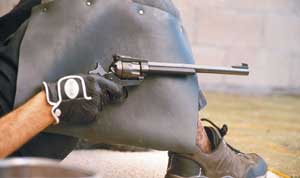 Rimfire revolvers have been the orphans of the target handgun world for
many years. The advent of rimfire metallic silhouette shooting has enabled the .22
revolver to claim a legitimate place among target handguns, as one of
the silhouette courses of fire is specifically for revolvers. The
accuracy demands of the match make it essential that the revolvers used
shoot better-than-average groups to remain competitive and give the
shooter a chance of shooting 40/40.
Rimfire revolvers have been the orphans of the target handgun world for
many years. The advent of rimfire metallic silhouette shooting has enabled the .22
revolver to claim a legitimate place among target handguns, as one of
the silhouette courses of fire is specifically for revolvers. The
accuracy demands of the match make it essential that the revolvers used
shoot better-than-average groups to remain competitive and give the
shooter a chance of shooting 40/40.
Any pistol used for metallic silhouette competition has to be able to shoot significantly better than 25mm groups at 25 metres with selected ammunition, otherwise the group dispersion will mean the shooter may miss the target even though he or she is holding perfectly.
In my pistol club, rimfire silhouette has become one of the most popular matches and more shooters travel away to silhouette events than to any other competition. There are a number of reasons for the match’s popularity and both old and new pistol shooters have found the match enjoyable and more satisfying to shoot because of its user-friendliness.
Firstly, the rimfire silhouette match has four divisions: production, standing, revolver and unlimited. Specialised pistols can be used for each, although many .22 target pistols will fit a number of categories. Free pistols can only be used in unlimited, but .22 autoloaders can be used in production, standing and unlimited. The popular Contender single shot pistols can be used in all but the revolver division and only revolvers can be used for all four divisions. Thus, an accurate revolver is the key to shooting the whole program with one pistol.
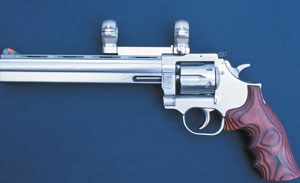 Secondly, the match can be shot from any position (other than the
standing match) and most shooters prefer to shoot from the Creedmore
position. This requires the shooter to lie on his or her back with feet
towards the target. It was derived from matches shot with long
barrelled target rifles in the USA at the Creedmore Range late in the
19th century. This is a very stable shooting position, as the shooter
can rest the pistol against the side of his or her thigh and calf,
resolving many of the difficulties pistol shooters face when having to
shoot the off-hand matches, one-handed. The critical issues of sight
alignment and trigger control are much easier to deal with when
horizontal.
Secondly, the match can be shot from any position (other than the
standing match) and most shooters prefer to shoot from the Creedmore
position. This requires the shooter to lie on his or her back with feet
towards the target. It was derived from matches shot with long
barrelled target rifles in the USA at the Creedmore Range late in the
19th century. This is a very stable shooting position, as the shooter
can rest the pistol against the side of his or her thigh and calf,
resolving many of the difficulties pistol shooters face when having to
shoot the off-hand matches, one-handed. The critical issues of sight
alignment and trigger control are much easier to deal with when
horizontal.
The time for each series is two minutes for five shots, so the shooter has a reasonable amount of time to get off carefully aimed shots without the pressure associated with the timed fire matches. The match itself is the most social of all competitive pistol events, as each shooter has a spotter to call the fall of each shot. The spotter is effectively a personal coach who can advise on sight and hold adjustments in the course of the match. Finally, the match provides instant gratification for both shooters and spectators, as targets that are hit fall down and those that are missed stay up.
The availability of consistently accurate revolvers with sights, triggers and barrel lengths suitable for the match is more restricted than almost any other competitive pistol shooting discipline. Longer barrels are preferred and most silhouette revolver shooters prefer 200mm or 250mm barrels. Perusal of current catalogues shows how short the shopping list is: Ruger’s Super Single Six, Smith & Wesson’s Model 617, Freedom Arms Model 83 Silhouette and Dan Wesson’s new Model 722. Arminius (Weirach) of Germany also produces a silhouette version of one of its revolvers, but these have not been readily available here and I have not yet seen one on the firing line, although their performance is reputed to be good.
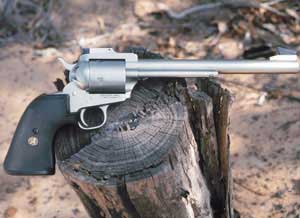 The problem many shooters have with any open sighted pistol is in truly
determining its full accuracy potential. I have taken to fitting scopes
to any of my target pistols where practicable and this will soon allow
an accurate assessment of the pistol/ammo combination to be made.
The problem many shooters have with any open sighted pistol is in truly
determining its full accuracy potential. I have taken to fitting scopes
to any of my target pistols where practicable and this will soon allow
an accurate assessment of the pistol/ammo combination to be made.
Pistol scopes are not required, as the low recoil of a .22 rimfire poses no danger if shooting the pistol with a rifle scope with its short (100mm) eye relief. I use a 4x Tasco air rifle scope for most of my handgun testing as it can be focused down to 25 metres, whereas many high-power rifle scopes have difficulty at such close range.
Even when shooting off a sandbag rest, there is a surprising amount of movement that is simply invisible when shooting with open sights and 10mm of sight oscillation is not uncommon. This obviously compounds the aiming and ammunition variations that produce the group.
Freedom Arms revolvers have an enviable reputation for accuracy and are by far the most expensive, with their US price tag leaving little change from $4000 for Australian shooters. The Freedom Arms Model 83 is a single action design, loaded through a loading gate. These superbly made revolvers have very tight chambers and it is not unusual to see their owners using a ‘pusher’ to seat the cartridge into the chamber.
At the other end of the scale, Ruger’s Super Single Six in the longer barrelled variants can provide great value, as most Ruger revolvers shoot quite well and some are exceptionally accurate. The Ruger has some limitations with its sights as they are not quite as up-market as the more expensive guns, but are still quite adequate to deliver good scores in competent hands. The relatively long single action hammer fall on the Ruger is no disadvantage in revolver silhouette and the single action trigger is relatively easy to tune up within the rules of production class pistols.
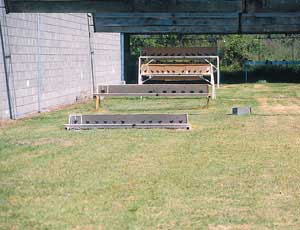 Smith and Wesson’s Model 617 and its earlier variants (the Model 17)
have good credentials, but, in my experience, are more variable in
their performance and can prove to be very particular with respect to
their ammunition. A good one can keep up with the best of them and I
have seen 617s capable of shooting chicken targets at 50 metres, while
others would have trouble hitting a ram target at 20 metres.
Smith and Wesson’s Model 617 and its earlier variants (the Model 17)
have good credentials, but, in my experience, are more variable in
their performance and can prove to be very particular with respect to
their ammunition. A good one can keep up with the best of them and I
have seen 617s capable of shooting chicken targets at 50 metres, while
others would have trouble hitting a ram target at 20 metres.
Other than actually shooting the revolver, it is difficult to anticipate its likely performance by examining it dimensionally. For this reason used S&Ws, particularly those used for silhouette competition by higher-grade shooters, are in high demand.
The new Dan Wesson series of .22 rimfire revolvers released in 2002 offers a mid-priced option with potentially consistently good performance, based on the company’s long-established reputation making centrefire revolvers. The interchangeable barrel system on these pistols gives shooters a range of barrel length options.
I was the first cab off the rank in Australia for one of these new Dan Wesson .22s and my very early production model (Serial Number 76) has had a very thorough workout with a wide range of ammunition. The 200mm barrel on the DW is supplied with scope mounts and this allowed the revolver to be fitted with a 4x scope for performance testing.
Good sights and a good trigger added to the attractiveness of this package for me and I was able to verify that accuracy was excellent with both the 200mm barrel and the 150mm barrel. Groups at 25 metres are consistently less than 20mm with selected ammo, with occasional groups coming in at half that size - great performance for a six-shooter.
The relatively tight chambers on the DW make it less user-friendly than other revolvers with some types of rimfire ammo with softer brass cases. The ejector cannot push all cases out at the same time and a rod is needed to remove the empties a chamber at a time, as per a single action revolver. With other brands of ammo with harder or thicker brass, ejection is no problem.
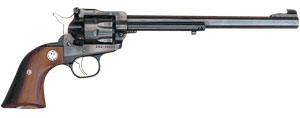 The clearances are so close on my DW revolver that softer brass causes
problems in another area. The case rim upsets with the firing pin
impact and the slight extrusion of the brass around the firing pin
drags on the recoil shield and interferes with rotation of the
cylinder. Again, this is ammunition brand dependent and can be avoided
by being selective.
The clearances are so close on my DW revolver that softer brass causes
problems in another area. The case rim upsets with the firing pin
impact and the slight extrusion of the brass around the firing pin
drags on the recoil shield and interferes with rotation of the
cylinder. Again, this is ammunition brand dependent and can be avoided
by being selective.
This highlights the challenge of getting consistent and reliable performance out of a revolver, as it is really six pistols in one and it is not news that the chambering on a rimfire is one of the most critical aspects of accuracy. Most single shot match rifles and pistols have chamber dimensions that feed the projectile into the rifling - quite impossible on a revolver.
I have not seen an Arminius silhouette revolver, nor do I know anyone who has used one in competition. According to Hermann Finken of Hermann’s Guns, who imports these revolvers, they are fitted with Lothar Walther barrels and are acceptably accurate, although not the most beautiful revolvers in the world. I believe these pistols come out of the Wierauch factory, which has an excellent reputation for the quality of its air arms.
In the 2002 Gun Digest, Taurus also lists a .22 rimfire silhouette revolver with a 300mm ventilated rib barrel and provision for scope mounts, but whether it will be available here remains to be seen.
Rimfire metallic silhouette is a great match and has a higher ‘fun factor’ than any of the more traditional rimfire events. An accurate revolver has all four individual classes covered with the added benefit of shooting the one gun using the one set of sight settings throughout the entire program. It is worth finding a good one.
